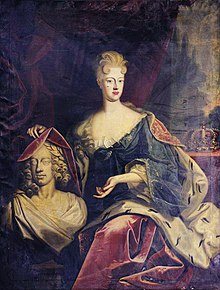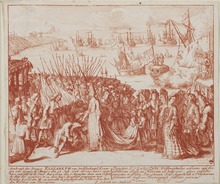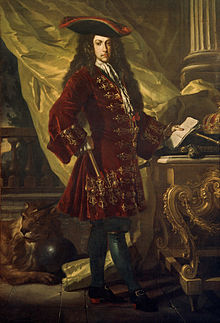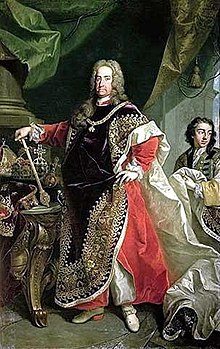Charles VI, Holy Roman Emperor
Charles VI Franz Joseph Wenzel Balthasar Johann Anton Ignaz (* 1 October 1685 in Vienna; † 20 October 1740 ibid.) was Roman-German Emperor and Archduke of Austria from 1711 to 1740, as well as sovereign of the remaining Habsburg hereditary lands, as Charles III. (Hungarian III. Károly) King of Hungary and Croatia, as Charles II. (Czech: Karel II. ) King of Bohemia, as Charles III. (Spanish Carlos III. ) designated counter-king of Spain, from 1713 as Charles VI. (Italian Carlo VI. ) king of Naples as well as by the peace of Utrecht from 1713 to 1720 as Charles III. (Italian Carlo III. ) also king of Sardinia, and from 1720 as Charles IV. (Italian Carlo IV. ) king of Sicily.
In the War of the Spanish Succession, Charles VI was unable to assert his claim to the Spanish crown, but a large part of the Spanish possessions in the Netherlands and Italy fell to Austria. His time as emperor saw the enactment of the Pragmatic Sanction. This not only allowed female members of the House of Habsburg to succeed to the throne, but with its emphasis on the idea of union among the Habsburg states, was central to the emergence of Austria as a great power. Victory in the Venetian-Austrian Turkish War led to territorial expansion in 1717. However, the territories won were partially lost again in the Russo-Austrian Turkish War of 1739. He spent much of his reign enforcing the Pragmatic Sanction within the Habsburg sphere of power and gaining its recognition by the other European powers. Domestically, the emperor endeavoured to promote the economy in the spirit of mercantilism. However, he abandoned an important project, the East India Company, in the interest of enforcing the Pragmatic Sanction. Nor did he achieve any reform of the administration and military. He was the last emperor to pursue not only Habsburg interests but also an active imperial policy, although the imperial idea lost much of its importance in his time. He promoted art and culture in many ways. His reign marked a high point in Baroque culture, the buildings of which continue to characterize Austria and the former Habsburg states to this day. With Charlemagne's death the House of Habsburg became extinct in the male line.
Emperor Charles VI in regalia as Grand Master of the Order of the Golden Fleece, painting by Johann Gottfried Auerbach.
Charles' signature:
Origin and family
Charles (baptized Carolus Franciscus Josephus Wenceslaus Balthasar Johannes Antonius Ignatius) was the son of Leopold I of the House of Habsburg and Eleonora of Palatinate-Neuburg, as well as the brother of Joseph I. His education took place under the supervision of Prince Anton Florian of Liechtenstein. The content was imparted mainly by Jesuits such as Andreas Braun or persons close to them. The teaching of traditional ruler virtues and in particular the history of the Habsburg family played an important role. Two manuscripts have survived from Karl's childhood in which he described the virtues of his ancestors.
Like every Habsburg, he had to learn a trade, choosing to train as a gunsmith. In the course of his training, Karl made a pen and ink drawing of a falconry gun barrel at the age of sixteen, which is now on display in the permanent exhibition of the Museum of Military History in Vienna. The drawing is signed by his own hand on the back ("Carl Erzh. zu Oesterr.").
Karl married Elisabeth Christine, daughter of Duke Ludwig Rudolf of Brunswick-Wolfenbüttel and his wife Christine Luise of Oettingen, on 23 April 1708 (long-distance marriage), and moved with her to Barcelona on 1 August 1708. The following children were born of the marriage:
- Leopold Johann (*/† 1716), Archduke
- Maria Theresa (1717-1780) ⚭ 1736 in Vienna Franz I Stephan of Lorraine
- Maria Anna (1718-1744) ⚭ 1744 Duke Charles Alexander of Lorraine
- Maria Amalia (1724-1730), Archduchess

Empress Elisabeth Christine of Brunswick-Wolfenbüttel
War of the Spanish Succession
In view of the imminent extinction of the Spanish line of the Habsburgs after the death of Charles II, Emperor Leopold intended early on to make Charles king of Spain. Already during the War of the Palatinate Succession it was planned to send the emperor's son to Spain together with auxiliary troops, but this did not come to pass. The Spanish king himself, however, did not appoint Charles but Philip of Anjou, a grandson of Louis XIV, as his heir. After the death of the king, Philip was recognized as king in Spain and the colonies. The resistance of Emperor Leopold, who allied himself with England and the Netherlands, triggered the War of the Spanish Succession.After Charles's proclamation as King of Spain in 1703, all Spanish possessions with the exception of Lombardy were granted to him by Emperor Leopold and his brother Joseph in a treaty kept secret. At the same time a settlement was concluded concerning the succession to the House of Habsburg (Pactum mutuae successionis). From Portugal, Charles hoped to enter Spain in 1704. However, the Portuguese and English troops were too weak to be able to break the resistance of the Spanish army. Taking advantage of the dissatisfaction of the Catalans and Aragonese with Philip V's regime, Charles succeeded in 1705 after the siege of Barcelona. Charles was able to extend his sphere of power to Catalonia and other territories and raise his own troops. He proved brave and tough during this period, but showed little ability to integrate or lead. Pressed by the French, Charles had to vacate some positions as early as 1706. The struggles of the allies were also not very successful. So they had to evacuate Madrid again in June 1706. However, the allies succeeded in conquering important Spanish possessions in Italy. For a time, Charles was also able to enter Madrid in 1710 after military successes in Spain, but soon had to retreat to Barcelona again.

Elisabeth Christine of Brunswick's arrival in Catalonia, 1708

Charles VI at the time of the War of the Spanish Succession
Search within the encyclopedia

.PNG)